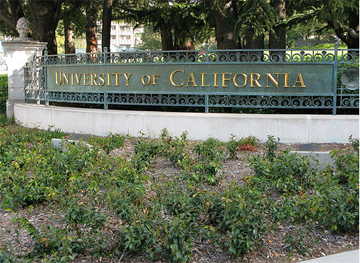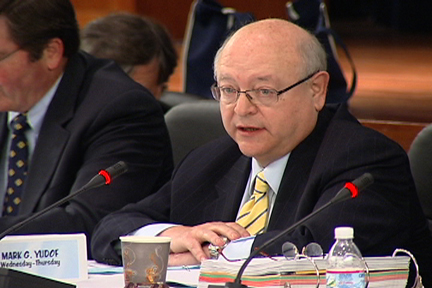Now that California has finally passed a budget, public higher education officials are moving forward with the difficult task of implementing cuts that will greatly impact students and educators.
And as University of California officials discuss additional reductions, some faculty members at the UC Berkeley campus say cuts are being distributed unfairly. Certain sciences reportedly are seeing less than a quarter percent cut while the school’s physical education program funding is being cut in half.
Richard Walker, a UC Berkeley geography professor, said he’s not surprised that administrators would spare the budgets of science departments at the expense of others. His department faces a 16 percent reduction in its budget.
 |
| Photo by amarette |
“It’s no doubt that the university favors big science,” Walker said. “Science and labs are extremely expensive operations and as science has gotten more elaborate, I understand they need a lot of money, a lot of equipment and a lot of labs.
“But the question is, overall, ‘Do we need as much natural science as we have and do we need less humanities and social sciences that educate us in other ways about other things?’” he said.
In a February article from The Daily Californian, Schlissel said that cuts to the physical education program would “ensure that there is enough money for students who take introductory biology classes and teaching assistants who manage the labs.”
UC Berkeley spokeswoman Marie Felde did not return calls. However, when asked via e-mail how university administrators decide what departments and programs to cut, Felde directed The Public Press to UC Berkeley’s budget Web site.
A higher education dilemma
The UC Board of Regents recently approved employee furloughs to help bridge the 10-campus system’s $813 million gap. The furloughs will provide an estimated $184 million in payroll savings for 12 months beginning this September, but more cuts are expected.
Like UC, the California State University Board of Trustees approved employee furloughs, as well as a 20 percent student fee hike. The CSU also will accept about 40,000 fewer students.
Faculty and staff members at throughout both systems are being asked to make sacrifices and some stand to lose their jobs.
"Everyone in the UC community is being asked to share the pain of our short-term solution, which is just one step toward finding the best ways to ensure long-term excellence and access for students and everyone we serve," said UC President Mark Yudof.
Other side of the coin
Sue Li-Jue teaches dance in UC Berkeley’s physical education program. Shortly after the spring semester ended in May, Li-Jue and 11 of her physical education colleagues received layoff notices that would take effect in fall 2010.
“It has been frustrating and disappointing,” she said. “I’ve been here for 23 years and all of a sudden, I feel like the rug has been pulled out from under me.”
The layoff notices could be rescinded if the university’s financial situation improves. But Li-Jue and swim instructor Elmar Stefke said they have no illusions about the state’s economic woes and recognize that the university could potentially lay them off if things don’t improve.
 |
| Photo by evoo73 |
“We were told that these layoff notices are only pro forma – that they are required in case they want to lay us off at the end of next spring,” Stefke said. “But obviously, these are legal, enforceable documents.”
Even before the layoff notices were handed out, Stefke said UC Berkeley officials had already proposed cutting the physical education program by 50 percent beginning this fall. Officials confirmed the cut in June, which will reduce full-time lecturers’ workloads to halftime.
The cuts would save the university $250,000, Li-Jue said.
Every academic year, the program attracts 5,000 students – 2,500 a semester – who take classes in dance, swimming, yoga, team sports and other activities. Li-Jue said as result of the proposed cuts, hundreds of students will be turned away because there will be fewer classes offered.
During this past spring semester, Li-Jue and her students tried to fight the cut by petitioning on campus, talking to administrators and writing letters about the need for physical education to help reduce student stress.
Dean Mark Schlissel of UC Berkeley’s biological sciences division, which oversees the physical education program, did not respond to requests for comment about the cuts.
How cuts are distributed
While some claim administrators value science programs more than others, UC astronomy professor Sandra Faber said it’s not a matter of playing favorites and that no one in the university system is immune to cuts.
In July, Faber helped gather more than 300 UC science faculty signatures for a letter sent to state lawmakers. The letter highlighted the negative impact the proposed 20 percent system reduction would have on the quality of UC’s science divisions, which are at risk of “slipping into mediocrity,” because prominent faculty would take better paying positions at other institutions, she said.
Faber, who is also the UC Santa Cruz department chair of physical and biological sciences, said her department is being cut by 5 percent this coming school year.
In deciding how to distribute cuts, Faber said, administrators look at “the quality of faculty in a given department, student demand and whether a program is nationally ranked.”
“Can we use this entity, whatever it is, to advertise UC and generate more revenue?” she said.
 |
| Photo by Ryan Greenberg |
However, when asked about the reductions in physical education at UC Berkeley, Faber said she’s not in favor of this.
“I think it’s a tragedy that P.E. would be cut by 50 percent by any university,” she said.
Meanwhile, UC San Francisco is losing 25 percent of its state funding for the 2009-10 fiscal year.
UCSF has other sources of funding from sponsored research, private endowments and clinical revenues, but Chancellor Michael Bishop said the campus still has to cut 355 faculty positions.
The UCSF spokesperson declined to comment about the claims suggesting science units of the system are valued more than others.
“Soft” money a factor in weighing program value
At San Francisco State University, health education professor Ramon Castellblanch had a response similar to Faber’s about how cuts are distributed.
“The programs and departments that have high ratios of students to teachers tend to be the ones that the administration wants to keep,” said Castellblanch, who also is the president of San Francisco State’s faculty union. “The ones that have low ratios of students to teachers are probably more vulnerable – it’s pretty straight-forward math.”
SF State is dealing with $36 million in cuts, Castellblanch said, as the CSU system tries to plug its $584 million budget hole. Although CSU schools operate differently than UC, he said factors other than student demand come into play when officials consider where to make reductions. He said “the capacity to pull in soft money (non-state funding) is the thing that protects hard sciences at (UC Berkeley or UCSF).”
“We get some soft money at SF State, but nowhere near as much as they do,” Castellblanch said. “The CSU’s are a lot more hard money (state funding) institutions.”
“UCSF is built on soft money,” said university Chancellor Michael Bishop at the UC Regents meeting on July 15. “Ninety-two percent of our operating budget and 82 percent of our payroll are non-state funds.”
But a loss in state funding will still hurt the university and patient care, said Bishop, who pleaded — and convinced — the regents to spare key UCSF employees from the 8 percent salary reduction and furlough program.
Mark Laret, UCSF Medical Center’s chief executive officer, recently announced that medical center employees and non-physician and clinically related employees at the School of Medicine and School of Dentistry will not be furloughed or have their pay decreased, as part of a plan Yudof approved. Instead, UCSF officials will implement other measures that will create $45 million in savings: an option for employees to leave voluntarily with severance; elimination of vacant positions; program closures; staggered layoffs and time reductions; as well as salary cuts for senior management.
 |
| UC President Mark Yudof |
In the meantime, Yudof said, as additional reductions are being decided, everyone in the UC system will have to “share the pain” – including top administrators like himself, who are on track to receive 10 percent in salary cuts for 2009-10.
For UC Berkeley lecturers like Li-Jue, whose jobs are on the line, the cuts that administrators face provide little consolation.
“We understand that there’s a budget crisis,” she said. “But why are the cuts not across the board?”










